This was published 6 months ago
‘Absolutely incorrect’: The evidence is in on whales and offshore wind farms
Those who hold doubts about offshore wind farms may not be aware that their misgivings have been deliberately planted.
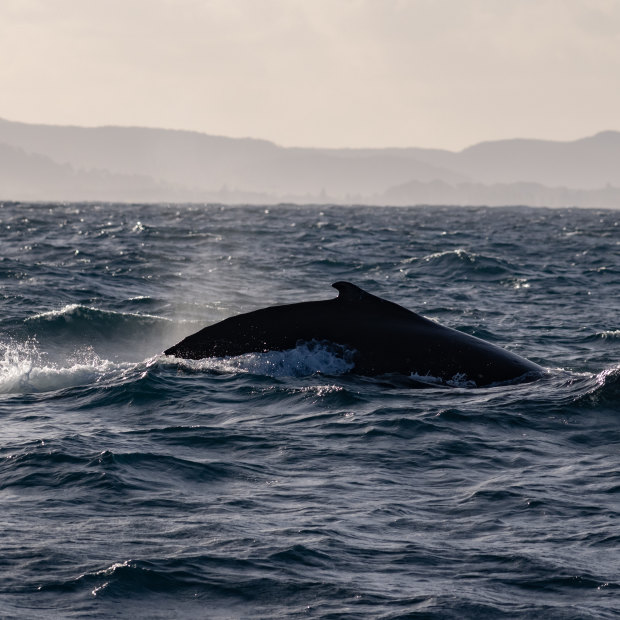
Whales migrating north off the Sydney coastline.Credit: Wolter Peeters
In a famous scene from The Devil Wears Prada, the fashion magazine editor played by Meryl Streep delivers an excoriating monologue about why her assistant’s dowdy jumper is not just blue but “cerulean”.
She explains the cerulean trend started with Oscar de la Renta, other designers followed suit, and then it “trickled on down into some tragic casual corner where you, no doubt, fished it out of some clearance bin”.
“It’s sort of comical how you think that you’ve made a choice that exempts you from the fashion industry when, in fact, you’re wearing the sweater that was selected for you by the people in this room,” she says.
When you talk to people who are concerned about offshore wind developments harming whales, they are similarly unaware that the doubts in their mind have been deliberately planted there. Decisions made in private rooms have reverberated around the world.
The science is clear: offshore wind farms do not hurt whales. If you have heard otherwise, it is ultimately because of a disinformation campaign funded by fossil fuel interests based in the United States.
The idea was dreamt up by conservative think tanks along with phrases like “wind factories” and “industrialisation of the sea”, put out by front groups disguised as grassroots campaigners, and then trickled down to NIMBYs and people genuinely concerned about whales.
That’s not to say there are no impacts on wildlife. There are, both good and bad. Offshore wind farms are brilliant news for fish, but dangerous for many seabirds unless the risk is mitigated.
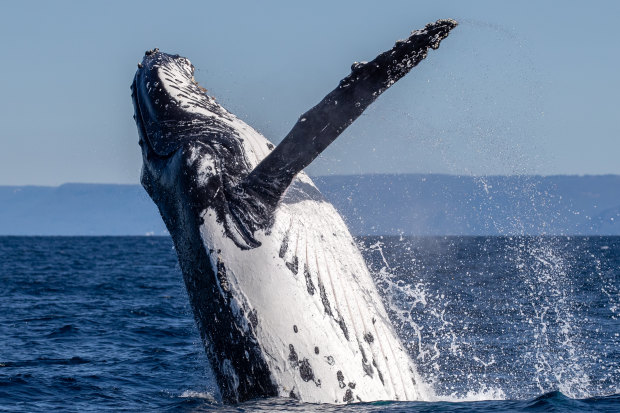
A humpback whale off the coast of Cronulla and Bundeena this winter.Credit: Rachelle Mackintosh/Cronulla Whale Watching
Offshore wind farms do not harm whales
Dr Olaf Meynecke, a research fellow at the Coastal and Marine Research Centre at Griffith University, is unequivocal.
“The claims that are made by some members of the public or some politicians that it is going to kill whales are absolutely incorrect,” Meynecke says.
The biggest risks to whales are not wind turbines, but entanglement in fishing nets and ropes, collisions with ships, whaling, plastic pollution, overfishing, especially of Antarctic krill, and climate change.
Meynecke says there are extensive offshore wind farms in the North Sea and Baltic Sea, off the coasts of Germany, Denmark, Norway and Britain, and the effect on wildlife, including whales, has been studied for more than a decade.
In North America, there is similarly no credible evidence of negative effects on whales from offshore wind developments.
Benjamin Laws, deputy chief for permits and conservation with NOAA Fisheries Office of Protected Resources, in the US says: “I want to be unambiguous: There is no information supporting that any of the equipment used in support of offshore wind development could directly lead to the death of a whale.”
The declared offshore wind zones off the coast of the Hunter-Newcastle region and the Illawarra in NSW and the proposed zone off Bunbury in Western Australia are in the pathway of Australia’s major migratory corridors for whales. Humpbacks in particular spend summer in Antarctica and mate and calve in subtropical and tropical waters further north.
The declared offshore wind zones off the coast of Gippsland, the Southern Ocean in western Victoria and the proposed zone in Bass Strait, Tasmania are not in migratory corridors but in whale feeding areas.
Meynecke says whales learn a map of the migration route and navigate around obstacles. He says wind turbines along a whale migratory channel should be at least 15 kilometres out to sea to ensure that whales can safely pass closer to the shore, rather than pushing them beyond the continental shelf where the swell is bigger.
Information from the Department of Climate Change, Energy, the Environment and Water shows the NSW and Western Australia zones are at least 20 kilometres out to sea at the nearest point.
Meynecke says there could be regular maintenance boats given the sometimes rough swells and winds off the east coast. He suggests the operators might need to reduce this for a few weeks each year during the whale migration, but this was “manageable”.
The typical wind turbine is a structure affixed to the sea floor, but the Australian government has proposed floating turbines in deeper waters. The department says the floating turbines will be required to be affixed to the sea bed with chains, cables or anchors.
Meynecke says whales would still know the floating turbines were there and in fact, the chains would probably be “noisier” than a fixed structure. This could be a stressor, but only if the animal was already close.
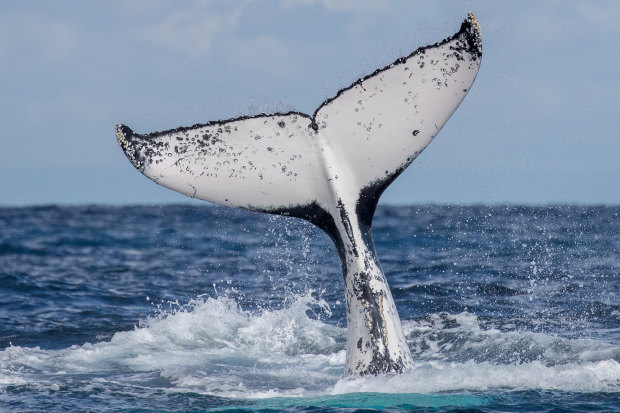
Humpback whales off the coast of Cronulla and Bundeena this winter.Credit: Rachelle Mackintosh/Cronulla Whale Watching
In the US, some of the claims are not that wind turbine structures are hurting whales, but specifically that the sonar used to survey the sea floor for offshore wind turbines is to blame for a rise in whales beaching.
The Marine Mammal Stranding Centre in New Jersey rescues and rehabilitates live beached whales and performs necropsies on the dead ones to determine the cause of death.
An article published by the Sierra Club says anti-wind activists have been demanding the centre make a close examination of whales’ ears to detect signs of damage from sonar. When the beached animals are not too decomposed, the centre has carried out an extensive examination including CT scans and lab analysis, but has found no evidence of auditory trauma.
Instead, the centre has found a wide variety of possible causes of death, including blunt force trauma from suspected vessel strikes.
Astroturfing efforts to spread a whale of a lie
At the heart of the disinformation effort is a giant “astroturfing” effort brought to you by the same people who have funded climate change denial for years. Astroturfing refers to a fake grassroots campaign, and it also appears to have been used in Australia to fake support for gas field expansion in the Northern Territory.
In the US, the front groups opposing wind turbines allegedly on behalf of whales have benign names like the American Coalition for Ocean Protection and Save Right Whales.

Anne Hathaway in her “cerulean” jumper in The Devil Wears Prada.
Yet, Professor Timmons Roberts at Brown University on Rhode Island has credibly traced the disinformation back to the Atlas Network of think tanks, including the Caesar Rodney Institute, the Texas Public Policy Foundation, CFACT and the Heartland Institute. These groups in turn are funded by the likes of the giant oil company ExxonMobil and the Charles Koch Foundation, a prominent US right-wing think tank founded by the famous industrialist family.
It’s no accident that saving the whales from offshore wind farms has become a major Republican talking point from former president Donald Trump down. Conservative politicians in Australia have followed suit, with Opposition Leader Peter Dutton and the Nationals’ David Littleproud ramping up their opposition to offshore wind since last year.
Craig Kelly, the former Liberal MP and now national director for Pauline Hanson’s One Nation, posts regularly about whales and offshore wind turbines. Recently, he responded to the announcement of the Illawarra offshore wind zone, by posting on X an illustration of offshore wind turbines anchored to the sea floor in an interlocking pattern and a whale entangled in a cable while Climate Change and Energy Minister Chris Bowen looks on laughing. Kelly claims whales would struggle “to weave their way through a spider’s-web of mooring lines and power cables from 300 floating wind turbines”.
Meynecke says it is impossible for whales to become entangled in chains, unlike with fishing line, nets or rope, while the department says offshore wind turbines overseas are generally 2 kilometres apart.
This masthead last year reported that wind opponents were circulating a fake article purporting to be from the internationally esteemed academic journal Marine Policy that claimed offshore wind farms off the coast of the Illawarra and Newcastle region would kill 400 whales a year. The editor of the journal says the article was entirely fabricated.
Dr Jeremy Walker, senior lecturer in the social and political sciences program at the University of Technology Sydney, says opposition to wind energy is not new in Australia, but the specific arguments about whales are a more recent development that has been imported from the US.
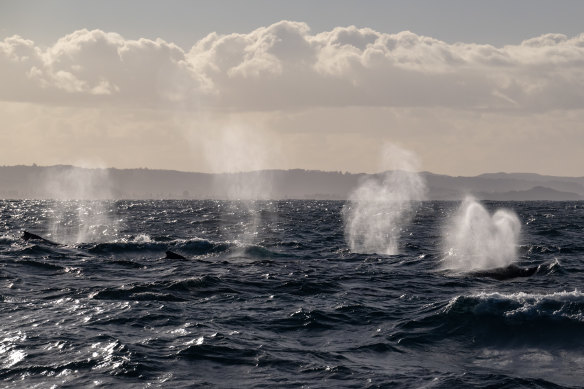
Whales spout as they migrate off the coast of Sydney this month.Credit: Wolter Peeters
The anti-wind talking points and memes shared in community Facebook groups mirror the effective anti-wind campaigns in the US. In Port Stephens, billboards have appeared bearing a photograph of a dead whale and a slogan calling for the proposed wind farm to be stopped. People attending anti-wind protests in Wollongong are given professionally printed placards with the same designs and messages as demonstrations in the US. For Walker, this is evidence that the organised anti-wind groups in Australia are also funded by the Atlas network. At the very least, it is clear the groups are spreading the same propaganda.
Of course, many well-meaning people are genuinely worried about the whales without understanding the source of the information, in the same way that the Hathaway character in The Devil Wears Prada was clueless about the origin of her cerulean jumper. But just because they don’t know, it doesn’t mean it’s a coincidence.
Offshore wind turbines are dangerous for seabirds
Not all concerns for wildlife are the result of disinformation. The claim that seabirds are at risk from being decapitated in the blades of the turbines is true, though manageable.
In Britain, where the offshore wind industry is more advanced, the risk to seabirds is now a major consideration in the approval process.
A 2023 study published in Austral Ecology found the Australian birds at most risk were various species of parrots, terns, curlews, godwits, and albatrosses. This was based on the regions where different birds live, and also how high they typically fly and whether that would be above or below the turbines.
The journal article suggests one approach could be to improve habitat in other regions to compensate, as a form of “offsetting”.
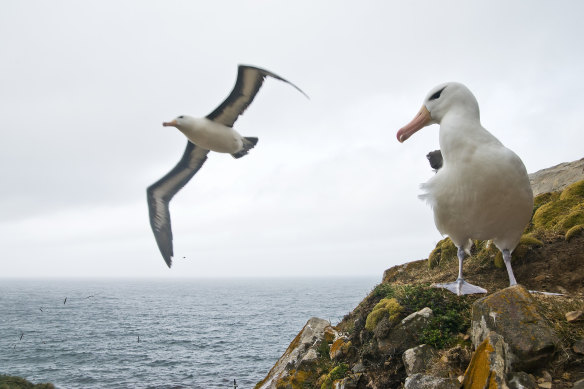
Albatrosses are among the most threatened birds, and at significant risk from offshore wind turbines.
A submission to the government from Humane Society International about offshore wind development focuses on the threat to seabirds, especially albatrosses, which are all either endangered or threatened.
Albatrosses, petrels and shearwaters do not follow narrow, predictable migratory pathways. Their eyes are evolved to scan the water for food in an environment usually free of obstacles above the water like spinning turbines. The problem is compounded by the fact they can fly at night, and power-nap on the wing.
The submission supports renewable energy because climate change is also an existential risk to seabirds, but calls for mitigation measures to reduce deaths from the turbines.
‘From a fish perspective, this presents habitat … wherever there are rocks or real estate [on the sea floor], those fish will come.’
University of NSW professor Iain Suthers
The charity calls for requirements for pylon design and blade heights to be informed by existing and new research. For example, it says, vertical axis turbines with a helix-like structures pose less collision risk than the large spans of traditional windmill horizontal axis turbines.
Humane Society says the fact that wind turbines are another threat on the scene makes it even more important to stop deaths of albatrosses as bycatch from longline and trawl fishing.
Offshore wind farms are great for fish
It is not all bad news. If you are a fish, or someone who likes to catch fish, offshore wind farms are hugely beneficial.
Professor Iain Suthers from the University of NSW says the chains or anchors attached to the sea floor will act as an artificial reef with benefits to the whole ecosystem, in a similar effect to wellheads on oil rigs.
“From a fish perspective, this presents habitat,” Suthers says. “The sea floor is often featureless and wherever there are rocks or if you build real estate, those fish will come.”
The structure will attract kelp and invertebrates including sea squirts, small crabs, and barnacles, which feed on the currents and a “conveyor belt of plankton” to feed other fish.
The moorings will attract deep water species, which off the coast of Newcastle and Wollongong would include pink snapper, flathead, blue morwong, and red fish.
It will also attract pelagic fish closer to the surface, including species such as yellowtail scad, which is eaten by humans, seals, sharks, dolphins and bigger predatory fish such as yellowtail kingfish and dolphin fish.
Bowen has said he expects recreational fishers will be able to travel and fish within offshore wind zones.
If bigger commercial vessels can’t navigate around the turbines, it could create an effective marine reserve. Suthers says these exclusion zones generally produce bigger, more fertile fish that produce eggs and larvae destined for nearby areas.
Get to the heart of what’s happening with climate change and the environment. Sign up for our fortnightly Environment newsletter.